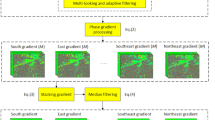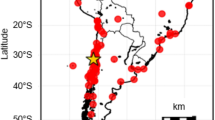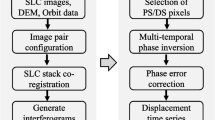Abstract
Fifty-five descending images from the ENVISAT satellite were processed using the small baseline subset (SBAS) method to derive the spatial and temporal ground deformation of the Bailong River Basin between 2003 and 2010. The basin is one of the most severely landslide- and debris flow-affected areas of China. As a result, 104 sites with high deformation areas were identified. Interferometric Synthetic Aperture Radar (InSAR) analysis was combined with landslide inventory data and field surveys, and anomalous areas were classified into three main types: landslide; debris; and subsidence. Displacement rates up to 35 mm/yr were evaluated away from the sensor along a line-of-sight (LOS) direction. The results gained should allow a more accurate prediction and monitoring of landslides, debris, and subsidence; further, they demonstrate the capability of the SBAS method to analyze any displacement effect and identify dangerous and uninhabitable areas in the basin. The small baseline subset method can thus contribute to the prediction and prevention of geohazards in the area.












Similar content being viewed by others
References
Akbarimehr M, Motagh M, Haghshenas M (2013) Slope stability assessment of the Sarcheshmeh landslide, Northeast Iran, investigated using InSAR and GPS observations. Remote Sens 5(8):3681–3700
Bai S-b, Wang J, Zhang Z, Cheng C (2012) Combined landslide susceptibility mapping after Wenchuan earthquake at the Zhouqu segment in the Bailongjiang Basin, China. Catena 99:18–25
Bai S-b, Cheng C, Wang J, Thiebes B, Z-g Z (2013) Regional scale rainfall- and earthquake-triggered landslide susceptibility assessment in Wudu County, China. J Mount Sci 10(5):743–753
Berardino P, Fornaro G, Lanari R, Sansosti E (2002) A new algorithm for surface deformation monitoring based on small baseline differential SAR interferograms. IEEE Trans Geosci Remote Sens 40:2375–2383
Casu F, Manzo M, Lanari R (2006) A quantitative assessment of the SBAS algorithm performance for surface deformation retrieval from DInSAR data. Remote Sens Environ 102(3):195–210
Chen G, Meng X, Tan L, Zhang F, Qiao L (2014) Comparison and combination of different models for optimal landslide susceptibility zonation. Q J Eng Geol Hydrogeol 47(4):283–306
Ciampalini A, Bardi F, Bianchini S, Frodella W, Del Ventisette C, Moretti S, Casagli N (2014) Analysis of building deformation in landslide area using multisensor PsInSAR™ technique. Int J Appl Earth Obs Geoinf 33:166–180
Colesanti C and Wasowski J (2004) Satellite SAR interferometry for wide-area slope hazard detection and site-specific monitoring of slow landslides. In Proceedings Ninth Internat. Symposium on Landslides pp 117-125
Colombo A, Mallen L, Pispico R, Giannico C, Bianchi M and Savio G (2006) Mappatura regionale delle aree monitorabili mediante l’uso della tecnica PS. Proceedings of 10 National Conference ASITA, Bolzano, Italy, pp 14-17
Cui P, Zhou GG, Zhu X and Zhang J (2013) Scale amplification of natural debris flows caused by cascading landslide dam failures. Geomorphology 182:173-189
Dai F, Lee C, Ngai YY (2002) Landslide risk assessment and management: an overview. Eng Geol 64(1):65–87
Dijkstra T, Chandler J, Wackrow R, Meng X, Ma D, Gibson A, Whitworth M, Foster C, Lee K and Hobbs P (2012) Geomorphic controls and debris flows—the 2010 Zhouqu disaster, china. Proceedings of the 11th International Symposium on Landslides (ISL) and the 2nd North American Symposium on Landslides.
Ferretti A, Prati C, Rocca F (2000) Nonlinear subsidence rate estimation using permanent scatterers in differential SAR interferometry. IEEE Trans Geosci Remote Sens 38(5):2202–2212
Ferretti A, Prati C, Rocca F (2001) Permanent scatterers in SAR interferometry. IEEE Trans Geosci Remote Sens 39(1):8–20
Gabriel AK, Goldstein RM, Zebker HA (1989) Mapping small elevation changes over large areas: differential radar interferometry. J Geophys Res Solid Earth 94(B7):9183–9191
Hanssen RF (2005) Satellite radar interferometry for deformation monitoring: a priori assessment of feasibility and accuracy. Int J Appl Earth Obs Geoinf 6(3):253–260
Hooper A (2008) A multi-temporal InSAR method incorporating both persistent scatterer and small baseline approaches. Geophys Res Lett 35(16)
Hooper A, Zebker HA (2007) Phase unwrapping in three dimensions with application to InSAR time series. J Opt Soc Am A 24(9):2737–2747
Hooper A, Zebker H, Segall P, Kampes B (2004) A new method for measuring deformation on volcanoes and other natural terrains using InSAR persistent scatterers. Geophys Res Lett 31(23)
Hooper A, Bekaert D, Spaans K, Arıkan M (2012) Recent advances in SAR interferometry time series analysis for measuring crustal deformation. Tectonophysics 514–517:1–13
Jiang X-Z and Wen B-p (2014) Creep behavior of the slip zone of a giant slow-moving landslide in northwest china: The suoertou landslide as an example. Landslide Science for a Safer Geoenvironment, Springer, pp 141-145
Kampes BM and Adam N (2003) Velocity field retrieval from long term coherent points in radar interferometric stacks. Geoscience and Remote Sensing Symposium, 2003. IGARSS'03. Proceedings. IEEE 2003 International 2: 941-943
Li Z, Zou W, Ding X, Chen Y, Liu G (2004) A quantitative measure for the quality of InSAR interferograms based on phase differences. Photogramm Eng Remote Sens 70(10):1131–1137
Liu G, Jia H, Zhang R, Cen M and Zhang T (2010) Subsidence detection by PS-InSAR based on high resolution Terrasar-X images. Progress in Electromagnetics Research Symposium Proceedings Xi'an: Is n, pp 11-15
Massonnet D, Feigl KL (1998) Radar interferometry and its application to changes in the Earth’s surface. Rev Geophys 36:441–500
Meisina C, Zucca F, Notti D, Colombo A, Cucchi A, Savio G, Giannico C, Bianchi M (2008) Geological interpretation of PSInSAR data at regional scale. Sensors 8(11):7469–7492
Michoud C, Baumann V, Derron M-H, Jaboyedoff M and Lauknes TR (2015) Slope instability detection along the national 7 and the potrerillos dam reservoir, Argentina, using the Small-Baseline InSAR technique. Engineering geology for society and territory-volume 2, Springer, pp 295-299
Motagh M, Beavan J, Fielding EJ, Haghshenas M (2014) Postseismic ground deformation following the September 2010 Darfield, New Zealand, earthquake from Terrasar-X, CosMo-SkyMed, and Alos InSAR. IEEE Geosci Remote Sens Lett 11(1):186–190
Peltier A, Bianchi M, Kaminski E, Komorowski JC, Rucci A, Staudacher T (2010) PsInSAR as a new tool to monitor pre‐eruptive volcano ground deformation: Validation using GPS measurements on Piton de la Fournaise. Geophys Res Lett 37(12)
Schlögel R, Doubre C, Malet J-P, Masson F (2015) Landslide deformation monitoring with ALOS/PALSAR imagery: a D-InSAR geomorphological interpretation method. Geomorphology 231:314–330
Stramondo S, Bozzano F, Marra F, Wegmuller U, Cinti F, Moro M, Saroli M (2008) Subsidence induced by urbanisation in the city of Rome detected by advanced InSAR technique and geotechnical investigations. Remote Sens Environ 112(6):3160–3172
Van Westen CJ, Castellanos E, Kuriakose SL (2008) Spatial data for landslide susceptibility, hazard, and vulnerability assessment: an overview. Eng Geol 102(3):112–131
Zhao C, Lu Z, Zhang Q, de la Fuente J (2012) Large-area landslide detection and monitoring with Alos/Palsar imagery data over Northern California and Southern Oregon, USA. Remote Sens Environ 124:348–359
Acknowledgments
This study was supported by the International S&T Cooperation Program of China (ISTCP) (Grant No. 2013DFE23030), the National Key Technology R&D Program of China (Grant No. 2011BAK12B06), the Fundamental Research Funds for the Central Universities (lzujbky-2015-133), and the National Natural Science Foundation of China (No. 41172328). The ENVISAT images were provided by the European Space Agency (ESA) to aid geohazard assessments of the Bailong River Basin, and radar data processing was carried out by Hooper et al. We would like to thank Tan Long, Guo Peng, Wang Siyuan, and Cui Zhijie for their assistance given during the study. We are grateful to the reviewers and editor for their constructive comments vis-à-vis improving the manuscript.
Author information
Authors and Affiliations
Corresponding author
Rights and permissions
About this article
Cite this article
Zhang, Y., Meng, X., Chen, G. et al. Detection of geohazards in the Bailong River Basin using synthetic aperture radar interferometry. Landslides 13, 1273–1284 (2016). https://doi.org/10.1007/s10346-015-0660-8
Received:
Accepted:
Published:
Issue Date:
DOI: https://doi.org/10.1007/s10346-015-0660-8




